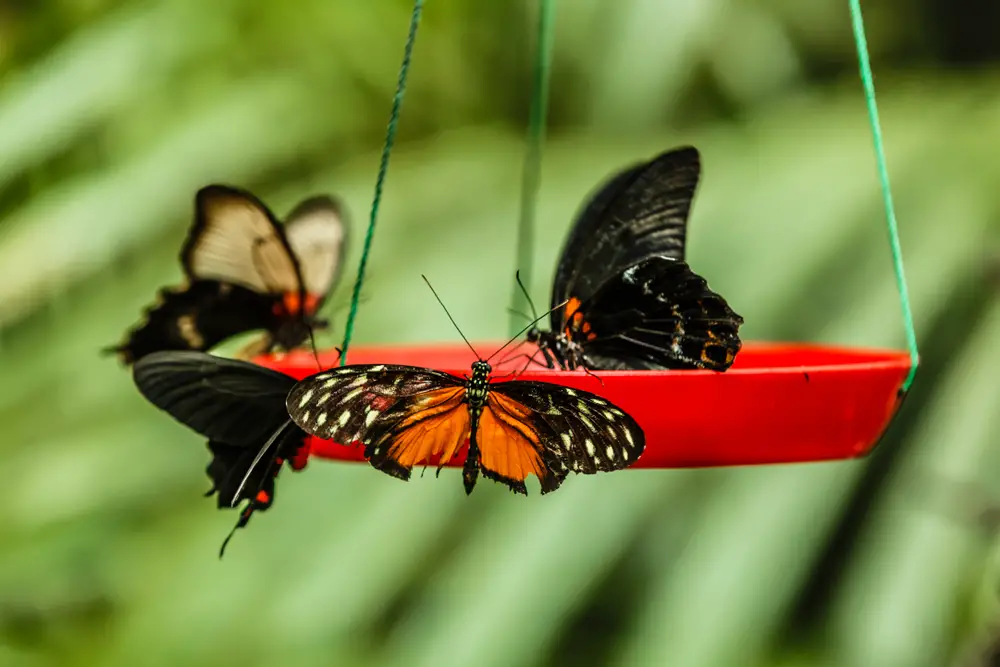Butterfly feeders are a great way to encourage butterflies to visit your garden, but perhaps you’d like to make one instead of buying one. Thankfully, making one is easy. So, here’s how to make a butterfly feeder!
To make a butterfly feeder, first, select the kind of feeder you want to make, gather the necessary supplies, make your feeder, fill it with fruit, fruit juice, Gatorade (red especially), or sugar water, put it in a sunny, visible spot in your garden, then wait for the butterflies to arrive!
Why Make A Butterfly Feeder
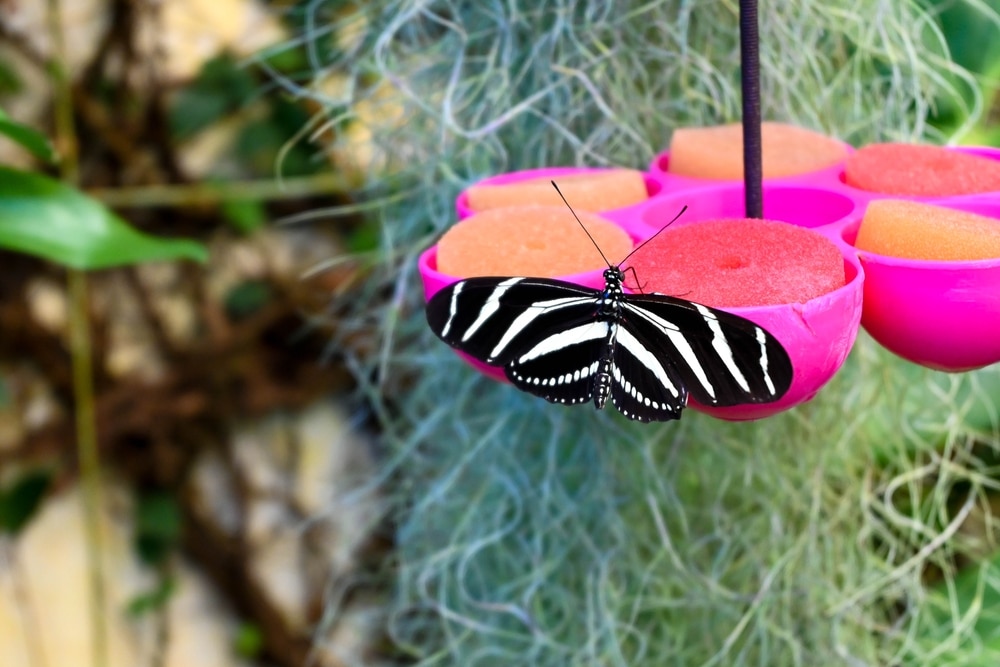
Making a butterfly feeder benefits not just butterflies but you too.
Only 10-15% of plants self-pollinate; the rest rely on pollinators (anything that carries pollen from flower to flower) to reproduce. This includes crops, which would decrease by up to 8% or more without pollinators.
In other words, we need more butterflies so all kinds of plants, including the ones we depend on, thrive.
Moreover, butterflies are beautiful. They add color and motion to your yard. They’re like living artwork!
Finally, making a feeder is fun. You can decorate it and hang it where you like (as long as it’s in the sunlight). Eventually, butterflies will come (within a week or two, sometimes a bit longer).
Supplies You’ll Need To Make A Butterfly Feeder
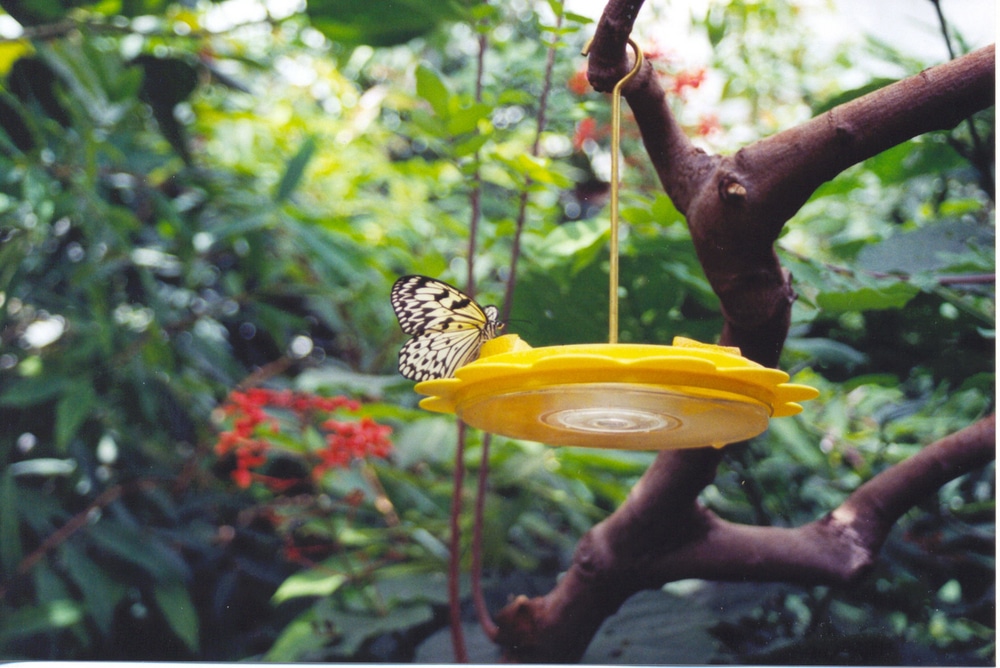
Before making your butterfly feeder, you’ll want to gather some supplies. Fortunately, you’ll probably have a lot of these already on hand!
Also, keep in mind that most butterfly feeders will need additional supplies (listed in the sections for how to make each feeder). The below supplies are universal, though (with some minor exceptions).
Twine
You’ll need something to hang your feeder with. I recommend twine since it’s both affordable and nice and sturdy. You’ll only need a foot or two, depending on the type of feeder.
You may also need glue to attach the twine to the feeder.
Food Source
Butterflies love fruit (especially overripe), fruit juice, Gatorade (especially red), or sugar water. You’ll need one of these for the feeder you plan to make.
For fruit, butterflies love mangos, apples, strawberries, nectarines, oranges, bananas, and more.
For sugar water, mix three teaspoons (tsp) of sugar per one cup of water (any water is fine). Make enough to fill your feeder. Boil the mixture until the sugar is dissolved, let it cool, then add it to the feeder.
A Container
You’ll need a container to serve as your butterfly feeder. Depending on the feeder you choose to make, you’ll need a terracotta pot, a dish, or a jar.
Decorations (Optional)
Since butterflies are drawn to brightly-colored things like flowers, you can always further decorate your feeder. Think fake flowers from your local grocery store, shiny beads, that sort of thing. Remember to use non-toxic paints if you decide to paint it.
What To Feed Butterflies
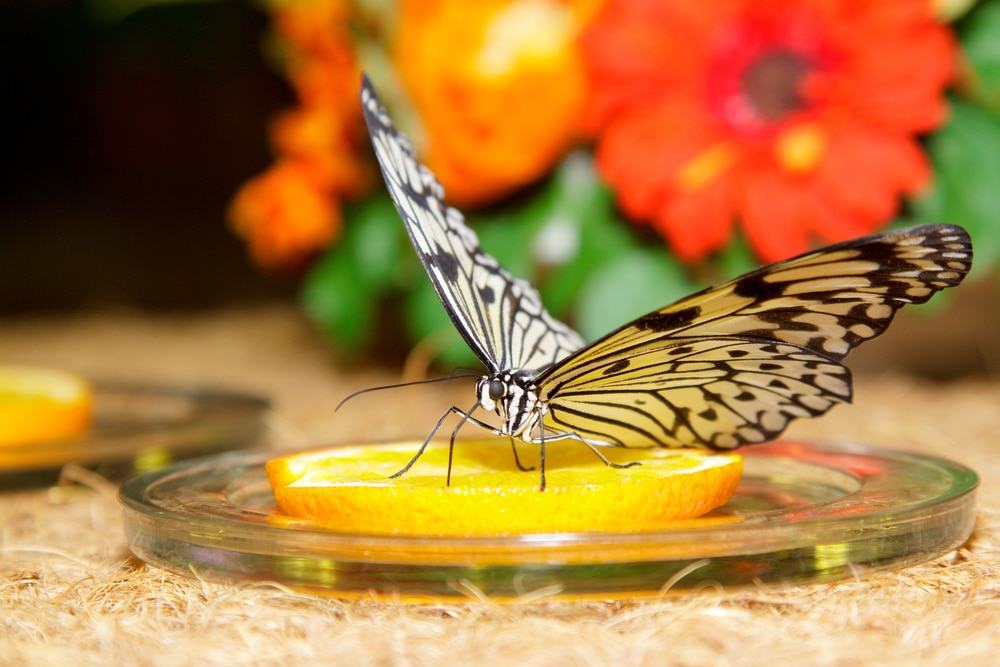
Butterflies love nectar. What you feed butterflies as an equivalent is up to you, but you have a couple of options.
In my experience, butterflies favor sugar water the most since it’s so similar to nectar. You can also feed butterflies ripe or overripe fruit, fresh fruit juice, and Gatorade (they especially enjoy red Gatorade). The dyes in Gatorade are minimal and not considered harmful to butterflies in general. The same goes for the dye in most juices, so most juice is okay, although you can always opt for juice with fewer ingredients to make it even healthier.
Just keep in mind all of these sweet foods are likely to attract more than just butterflies. Other common nectar lovers include bees, wasps, and hornets. Sugar water can also attract ants when you don’t place it up high enough (it’s best to always have a feeder hanging or on a pedestal).
While wasps and hornets are a risk for any butterfly feeder, they most enjoy fruit and are less attracted to homemade nectar. So, if you really don’t want wasps, you may want to opt for a nectar feeder over a fruit feeder.
How To Choose A Butterfly Feeder To Make
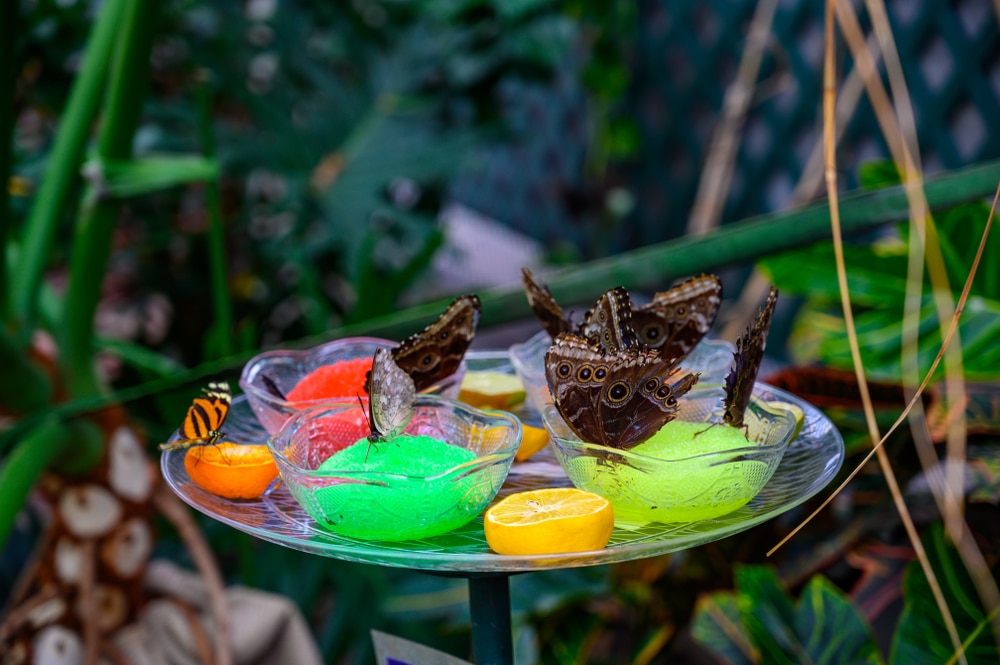
The best feeder for you is primarily a matter of personal preference. Whatever you like and think will work best for your situation is the one you should go with. You can also experiment with one, see if it works, then try another.
It also depends on what you have the supplies for or are willing to get. Most folks have a jar or two on hand and maybe some twine. But if you have old, ripe fruit, you may want to go with a dish feeder instead.
Or if you feel like making homemade nectar, or syrup, an upside-down jar feeder or sponge feeder will do the trick. I’ve had the most success with putting sugar in feeders. However, with patience, butterflies will stop by for fruit as well.
You’ll also want to consider the feeder’s location. Do you have anywhere to hang a feeder, or do you need a standing one (like the rocks-in-a-jar or terracotta pot feeders)?
Finally, do you feel like maintaining a feeder? Nectar feeders must be refilled every other day to two times a week. These are just some things to consider!
Where To Put Butterfly Feeders In Your Garden
Put butterfly feeders where butterflies can easily see and access them. If it’s a hanging feeder, hang it from something that can support the weight. Put it on a stable, level surface if it’s a ground feeder.
Always put your feeders in sunny spots, as butterflies love the sun.
How To Make A Butterfly Feeder With Step-By-Step Instructions
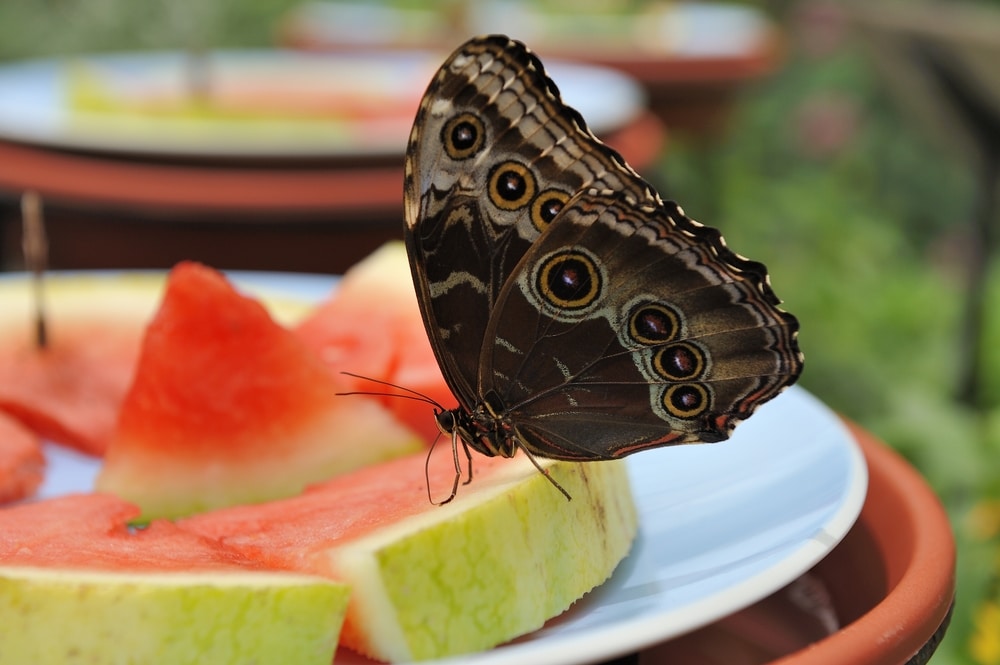
You have several options if you’re looking to make a butterfly feeder. These are simple but effective designs that have been proven time and time again to bring butterflies near.
Let’s start with a fruit hook feeder!
Hanger Fruit Hook Feeder
There are only two steps to make a hanger fruit hook butterfly feeder.
Step one is to grab some fruit. The fruit can be fresh or overripe but not rotten. Some butterfly favorites are ripe strawberries, oranges, watermelons, mangos, nectarines, peaches, apples, and bananas.
Step two is to take a metal clothes hanger or something similarly hook-like and put the fruit on the hook. Hang this off of a tree branch or with some twine, and you’ve got a handy DIY fruit hook butterfly feeder!
Suet Feeder
To make a butterfly suet feeder, first stop by your local grocery or pet store and get a suet feeder or two. Usually, you’d pick up some suet to put in these for your neighborhood birds.
However, you only need some fruit when using a suet feeder for butterflies. Butterflies especially like extra sweet and juicy fruits, like peaches, apples, oranges, mangos, and bananas.
So, the next step is to load up your suet feeder with the fruit, then hang it from or attach it to a tree. You shouldn’t worry about birds being drawn to the feeder, as most birds eat seeds rather than fruit. If you’d like to ensure no birds show up at the feeder, you can always avoid the small berries and fruit that certain birds (like robins) eat, such as cherries, blueberries, and grapes.
Rocks-In-A-Jar Feeder
As its name implies, a rocks-in-a-jar feeder made with just rocks and a jar (and some fruit).
Here’s how to do it:
- Pick A Jar: Any jar will suffice, although wide-rimmed jars will work even better!
- Fill The Jar With Rocks: Find a variety of rocks of your choice and fill the jar nearly to the brim.
- Place Fruit On Top Of The Rocks: Once the jar is full of rocks, you can place fruit on top (remember, some butterfly favorites are mangos, bananas, oranges, etc.).
- Put The Jar In Your Garden: You can either set the jar in your garden as is or raise it on rocks, a log, or some other kind of pedestal. Hanging the jar is also an option. Either way, make sure to choose somewhere sunny (and preferably with flowers or plants).
Terracotta Pot Feeder
For this feeder, all you need is a terracotta pot with a removable water-catching dish on the bottom, and some fruit, fruit juice, Gatorade, or sugar water!
- Place The Pot Upside-Down: Remove the water-catching dish from the terracotta pot, and place the pot upside-down so it works as a stand.
- Place The Water-Catching Dish On Top Of The Upside-Down Pot: You can glue it in place, but it’s unnecessary.
- Put Butterfly Food In The Dish: As with many other feeders, you can choose sugar water, fruit, fruit juice, or Gatorade.
- Place The Terracotta Pot In Your Garden: Remember to choose a sunny spot, preferably by flowers or other plants!
Dish Feeder
All you need for a dish feeder is a dish placed atop a rock (or another flat or level surface) and set somewhere sunny in your garden.
Here’s how to make it:
- Grab Food Butterflies Like: This can be fruit, fruit juice, or Gatorade. Any fresh fruit or fruit juice will do, and Gatorade is the same (although butterflies especially like red)
- Or Make Sugar Water Instead: To make sugar water, combine and boil three teaspoons of sugar for every one cup of water until the sugar completely dissolves, then let it cool. Do this until you have enough to fill your feeder.
- Find A Suitable Dish: You’ll want a shallow dish for your butterfly feeder (no more than 2-3 inches deep), so the butterflies can easily see its contents. If you opt for sugar water, you may want a slightly deeper dish; just make sure to fill it well!
- Fill The Dish: Place your chosen butterfly food in the dish.
- Set The Dish On A Raised Platform: A raised platform (a log or rock formation) is necessary so butterflies can see your feeder and you can avoid ants.
- Or Hang The Dish: Glue or tie some twine to the feeder and hang it in the sunlight. You can even hang a few dishes together (one below the other) this way for a nice butterfly buffet.
Sponge Feeder
The sponge feeder is another easy butterfly feeder to make. It involves some homemade syrup (slightly different from sugar water), some twine, and a sponge (or three).
Here’s what you need to do:
- Make Some Homemade Syrup: Mix and boil one quarter cup of sugar with one cup of water until the sugar dissolves, then let it cool (you can always double this amount if you have a particularly big sponge or would like to soak a few sponges).
- Grab A Sponge (Or A Few Sponges): Any sponge will do, as long as it’s clean and absorbent (it should soak up and hold onto the syrup mixture).
- Tie Some Twine To The Sponge: You can tie it to the middle of the sponge or the top. Doing this allows you to hang the feeder properly.
- Soak The Sponge In The Syrup: Make sure the sponge is nice and saturated!
- Hang The Sponge In A Tree (Or Somewhere Similar): Find a sunny spot to hang your new, homemade butterfly feeder!
(Upside-Down) Jar Feeder
This is a simple feeder that calls for a sponge, some sugar water, some twine, and a jar.
Here are the steps you’ll need to take to make it:
- Find A Jar: Any jar will do as long as it has a lid.
- Grab A Sponge: You can use a natural or synthetic sponge; just make sure it’s dense and absorbent (as a good sponge should be).
- Make Some Sugar Water Nectar Or Use Gatorade Or Fruit Juice: Combine and boil three teaspoons (tsp) of sugar per one cup of water (with six teaspoons and two cups total). Boil the sugar and water until the sugar is dissolved completely, then let it cool. Or, you can go the easier route and use Gatorade or fruit juice, which works equally well for this feeder.
- Fill The Jar: It doesn’t matter how full.
- Poke A Hole (Or Multiple) In The Jar’s Lid: Use a screwdriver or nail to poke a hole (or multiple) in the lid.
- Put The Sponge In The Hole In The Jar: Cut off a piece of sponge small to fit through the hole (or holes) but big enough to be snug. Place it in the hole or holes in the lid.
- Decorate The Jar (Optional): Adding drawings, fake flowers, or whatever else you like is a great way to personalize your jar feeder. Butterflies may even like it too!
- Tie Some Twine Around The Jar: When you tie twine around the jar, remember that you want it to hang upside down. I advise taking roughly four pieces of twine (about a foot long each) and wrapping each around the mouth of the upside-down jar. Space them equally from each other (dividing up the jar into four parts). Tie these together at the bottom of the jar, and use that to tie the hanging jar to the tree. Gluing the twine is also okay and may be easier/make the feeder sturdier.
- Hang The Feeder Upside Down In Your Garden: When you turn your jar upside down, the liquid will absorb partly into the sponge, so the butterflies can feed off the moisture.
How To Maintain A Butterfly Feeder
Depending on the butterfly feeder you choose to make, there may be some maintenance. For example, with sugar water feeders, you’ll need to replace the sugar water every other day to twice a week. Otherwise, the sugar will go bad and act as a butterfly repellent instead! You’ll also want to clean the feeder about once a week.
The same goes for feeders with Gatorade. You will need to replace it every other day to twice a week.
For fruit feeders, you can leave the fruit for a couple of days until it begins to rot. Then, you’ll want to remove it, rinse off the feeder (some water and dish soap will do), and replace it with fresh fruit.
So, every feeder requires some maintenance, but nothing too crazy. It’s up to you to decide whether it’s worth it to maintain a butterfly feeder!
Final Advice
Remember to have fun with the process of making your butterfly feeder. Stay patient after putting it out; you’ll soon see the butterflies (and might even be able to touch one). If you don’t, remember you can always try a new one!

